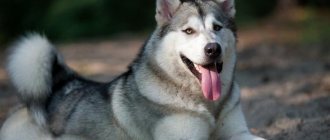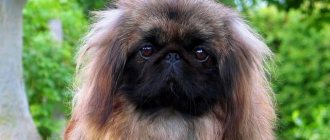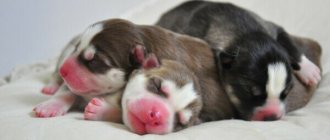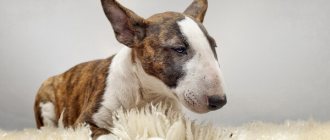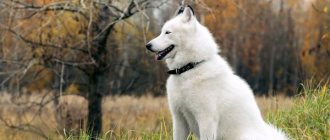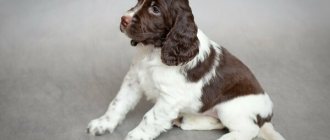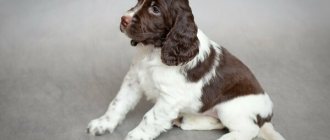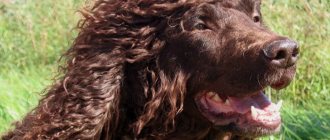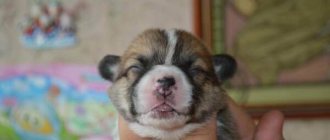Spaniels are a large group of breeds, mainly of the hunting type. These include such well-known breeds as the Russian Spaniel and the Cavalier King Charles Spaniel, as well as, of course, the Cocker Spaniel.
The Cocker Spaniel is an active, good-natured, cheerful and very energetic breed.
The dogs are medium-sized, muscular and strong, with beautiful wavy hair of various colors - black, white, golden, chocolate and others.
Originally hunting dogs, cocker spaniels are now considered one of the best companions for active people.
The first month of life and what it looks like in the photo
At birth, Cocker Spaniel puppies weigh about 200 grams, their eyes and ears are closed, and there are no teeth . The body of a newborn puppy is covered with short and soft “baby” hair.
Cockers' eyes and ears open at the age of 10-14 days, but they begin to see and hear well by 3-4 weeks. Baby teeth erupt between 2 and 6 weeks.
The table shows approximate measurements for Cocker Spaniel puppies . It is necessary to take into account the individual developmental characteristics of dogs. Slight deviations in height and weight are acceptable.
An underweight or overweight pet is a reason to contact a veterinary clinic..
| Age, months | Weight, kg | Features of age |
| 0 | 0,18 – 0,28 | Puppies with their mother do not feed on their own. |
| 1 | 1,4 – 1,6 | By 45 days, the puppies are ready to go to a new home. Unvaccinated people cannot go for walks. |
| 2 | 3,1 – 3,5 | Deworming, vaccinations, quarantine. Accustoming to a nickname, collar, toilet and diaper. |
| 3 | 5,2 – 6,0 | Walking outside, toilet training, starting training. |
| 4 | 7 – 8 | Education and training at this age bring the fastest and most noticeable results. Show puppies begin to attend shows in the baby class |
| 5 | 8 – 10 | The change of teeth begins. Damage to furniture and interiors is possible due to lack of attention and toys. With active and frequent walking, you can count on the puppy to relieve its natural needs only outside |
| 6 | 10 – 11 | A period of active growth. The coat begins to change from children's to adult's - smoother and tougher. |
| 7 – 8 | 11 – 12 | By this age, the puppy should have completely changed teeth and fur, and its height and weight should be close to adults. |
| 9 – 12 | 12 – 14 | The puppy is physically mature and active growth is ending. |
Possible diseases and methods of treating them
All spaniels are cheerful and positive. If they are sick, they lose their appetite, become sad and seek the company of the owner or household members. Some of them are prone to hip dysplasia. These dogs often suffer limb injuries while hunting.
In this case, they need to provide medical assistance. Hospitalize the supposedly sick dog, then a doctor will take care of it. If a limb is fractured/dislocated, you will have to take care of it at home.
Representatives of the breed in question have an excellent appetite, so they often beg their owners for feeding. They often succumb to manipulation and agree to feed their charming dogs. This cannot be done, because regular overeating by dogs is fraught with the appearance of digestive problems.
From puppy to adult dog
The period of active growth in Cocker Spaniel puppies usually ends by 10-11 months, but strengthening of muscles, ligaments and skeleton lasts up to 15-18 months.
Before this age, breeders recommend introducing vitamin complexes for growing animals into the dog’s diet.
The weight of an adult male cocker spaniel is 12-14 kg, height – 38-39 cm. Bitches weigh on average 10-12 kg, their height is 35-36 cm.
Description of the breed
The characteristics of the breed include the following standards:
- round head, proportional;
- the muzzle is wide, has a blunt edge;
- eyes are not protruding, dark;
- long drooping ears covered with thick hair - it is by this feature that everyone recognizes spaniels;
- the nose is large, black or brownish in color;
- has a squat, muscular, proportionally built body with smooth curves;
- powerful bite;
- The coat is double, soft and silky on top, with a thick undercoat underneath. In short, it's on the head.
Colors may vary. The standard allows for nuances in the color resolution of the breed. For example, for the English Kennel Club, white spots are a defect; only their presence on the chest is allowed. Solid color is recognized. But in general, there are two main colors of the breed - solid and spotted. Solid colors include red, black, chocolate and fawn. Pure white color is not acceptable. Most individuals are red. Cockers used to have their tails docked to prevent them from getting caught in bushes. Today, spaniels are kept at home as decorative pets; this procedure is not necessary. The height of an adult dog is approximately 38-41 cm, males are taller. The weight of an adult dog is 12.5-14.5 kg.
Features of care
By the time the puppy arrives, owners should take care to create a safe and comfortable environment in the home.
The list of acquisitions includes:
- bed
- diapers.
- bowls.
- comb.
- nail clipper
- toys and chewable treats.
- collar and leash.
- hair care products, ear cleaning lotions, toilet training sprays, anti-gnawing.
The dog's place should be set up in a quiet and warm part of the room, where the owner can devote maximum time and attention to the puppy.
CAREFULLY!
It is important to isolate electrical appliances, wires, equipment, hazardous substances and small objects from the puppy.
For ease of adaptation, you need to find out from the breeder the daily routine and nutrition of the puppy. The ideal option would be to continue feeding the puppy the same food, at least at first.
If you don’t plan to let the dog into your bed, don’t let it from the first day, even if the baby, confused without his mother and littermates, whines.
Simply move the dog bed closer to the bed and “cover” him with your hand - this is usually enough to calm the puppy.
Standard care procedures include:
- feeding.
- walking (when the puppy is already vaccinated).
- upbringing.
- bathing, brushing.
- nail trimming.
- care for eyes, teeth and ears.
- hygienic wool cutting.
Accustoming to cleanliness
You need to start training from the first days the puppy is at home. If your cocker spaniel has not yet been vaccinated, you need to teach him to go to the toilet in a diaper. To do this, several diapers are placed where the puppy sleeps, eats and plays, and other areas are isolated.
At 1.5 months, the cocker defecates approximately 5 times a day - after eating, sleeping, playing - the puppy’s behavior changes sharply, he sniffs restlessly, and at this moment carefully bring him to the diaper.
After he goes to the toilet in his place, be sure to praise him and give him a treat - this way you will reinforce his correct behavior and speed up the training process.
A fully vaccinated puppy can be taken outside two weeks after the second comprehensive vaccination. As soon as the puppy begins to restlessly look for a place to rest, you need to take him outside.
If by this moment the puppy is already wearing a diaper, you just need to take the diaper with you outside and lay it in the place where the puppy needs to go to the toilet.
Usually, toilet training takes 1 month, but due to their age, puppies can make mistakes up to 5-6 months.
When to wean from mother
It is necessary to separate puppies from their mother as early as possible.
Every dog breeder should know when it is best to separate newborn puppies from their mother. Until the age of one and a half months, babies should, if possible, live with a bitch. During this period, they feed on mother's milk and are not yet able to eat solid food. 45-50 days after birth, the mother stops feeding the doggies. They become more independent and can be moved to a new place.
What to feed?
The first three months of a Cocker Spaniel's life lay the foundation for a long, healthy and active life.
IMPORTANT!
It is important to feed your puppy complete and balanced food.
There are two ways to feed puppies and dogs - industrial ready-made food and homemade diets.
High-quality dry food saves time on preparation; it is balanced according to the age and size of the dog.
This can be food for medium breed puppies from: Royal Canin, Pro Plan, Hills, Purina ONE, Eukanuba, Monge, Brit Care, Pronature Original, Bosch, Acana, Now Fresh, Orijen, Grandorf, Go Natural holistic, Farmina N&D, Pronature Holistic.
The daily portion of food is indicated on the food packaging and is calculated based on the puppy’s weight. It is divided by the number of feedings and given out in equal shares. When feeding dry food, it is important to provide your puppy with clean water.
For a small puppy, feeding five times a day is optimal..
When feeding natural food, the owner is confident in the quality of the products and their origin. Meat, fish, cereals, dairy products, fruits, vegetables and herbs will help the puppy grow up healthy and vigorous.
At the age of up to 3 months, a cocker spaniel should eat approximately 6% of its body weight in food per day. With a weight of 3 kg, the daily portion of food is 180 – 200 g.
Of these, half are meat, 30% are cereals, 10% are vegetables and 10% are dairy products. The daily portion is divided by the number of feedings.
Sample menu for a 3 kg puppy for a week:
| Daily norm/5 feedings, gr. | Meat/fish, 100 grams per day. | Porridge, | Vegetables fruits | Dairy products | Additionally | |
| 1 | 200 | Beef | Rice | Apple, Carrot | Kefir | Boiled egg |
| 2 | 200 | Turkey | Buckwheat | Zucchini | Cottage cheese | Berries |
| 3 | 200 | Beef | Hercules | Cucumber | Unsweetened yogurt | Greenery |
| 4 | 200 | Lean sea fish without bones | Rice | Pear, Spinach | Kefir | Sea kale |
| 5 | 200 | Beef | Rice and buckwheat | Beet | Ryazhenka | Boiled egg |
| 6 | 200 | Lean pork | Hercules | Apple | Cottage cheese | Rosehip berries |
| 7 | 200 | Chicken | Buckwheat | Pumpkin | Cottage cheese | Banana |
Vaccination schedule
| Puppy age, months. | Vaccine | From what diseases | Revaccination |
| 1,5 | Nobivac DHPPi Biovac Vanguard plus 5 L4 CV Multikan Duramun Biocan DHPPi | against canine distemper, infectious hepatitis, parvovirus enteritis and canine parainfluenza | 14 days after the first, then every other year, annually |
| 1,5 | Nobivac L4 Biovac L Vanguard plus 5 L4 CV Multikan L Duramun L Biocan L | Against leptospirosis | 14 days after the first, then every other year, annually |
| 3, if the change of teeth has not begun or after a complete change | Nobivac Rabies Biovac R Multikan 8 Zoetis Defensor | Against rabies | Every other year, annually |
Only healthy dogs are vaccinated. Weakness, underweight, previous illnesses are reasons to postpone vaccination.
Deworming is carried out:
- once, 2-3 weeks before vaccination.
- in case of severe helminthic infestation - again, then vaccination is postponed.
Hygiene procedures
You can wash your puppy’s paws and belly with water after every walk, and bathe him with shampoo weekly. The standard procedure includes cleansing the coat and skin with shampoo and moisturizing the coat with conditioner.
The water should be warm, but not hot . After each wash, it is necessary to thoroughly dry the dog's coat, paying special attention to the ears.
When washing your puppy, try not to get water in the ears - this can cause otitis media..
Constant brushing of the coat will prevent the formation of tangles. Particular attention should be paid to the areas behind the ears, armpits, and groin. The Cocker Spaniel is groomed 4-5 times a year.
To do this, you can contact a groomer - a dog hairdresser, or learn how to cut your hair yourself.
In addition to the breed's haircut, once every 10-14 days, the puppy's ears are cleaned, his nails are trimmed, and the fur on his paw pads is trimmed. To clean the ears, apply lotion to a cotton pad and carefully wipe the entire visible space of the ear.
To clean teeth, use dog pastes and brushes or special chewing bones and treats . If the plaque on your pet's teeth is too pronounced, it is recommended to consult a veterinarian.
Distinctive features
The main parameters characterizing the English Cocker Spaniel:
- The head is regular in shape, with a clear outline.
- The ears are drop-shaped, long, thin, located in line with the eyes.
- The eyes are large, round, and dark shades of brown. Light eye color (light brown) is allowed in dogs with chocolate-colored fur.
- The nose is black with large nostrils (for a good hunter's instincts).
- The bite is scissor-shaped, the incisors develop strictly vertically.
- The back is physically well developed.
- The forelimbs are straight and small in size.
- The hind limbs differ significantly from the front limbs in their developed muscular system. Large hips, designed for fast running, characterize the dog's purpose as a hunter.
- Tail with thick hair. In an excited and joyful state, the height of the tail does not reach the height of the back.
- The coat is of medium abundance, without curls. Long hair is present on the legs and along the perimeter of the lower body.
Possible colors according to standard
How to choose?
The choice of a puppy should be approached with the utmost seriousness. In order to purchase a physically and mentally healthy animal, future owners turn to kennel clubs, breed forums, and nursery owners.
You should not choose a puppy based on the principle of the minimum price - this often means that the dogs and puppies are poorly raised, are not fed enough, do not have quality care and the necessary documents on origin.
The absence of a puppy card (birth certificate for puppies) should alert the potential owner - there is a danger of buying a non-pedigreed animal that will not look like a cocker spaniel with age.
When meeting puppies, you need to pay attention to the appearance of the mother and puppies - they should be cheerful, active and inquisitive, with shiny fur, clear eyes.
If the puppies are lethargic and hiding, it may be worth looking elsewhere.
Differences between a boy and a girl
Some people have some difficulty determining the sex of a puppy. However, in fact, determining the gender of a newborn dog is quite simple. To do this, you need to turn him over with his stomach up and carefully examine the area just below the navel. If the genital organ is visible in this place, then it is a male.
Additional Information! Female puppies have no visible or palpable seals on their bellies. However, they, unlike males, have a genital slit near the anus.
Price range
If a puppy’s exhibition and breeding career is planned, then the owners should expect a cost of 25-30 tr . If a puppy is purchased as a pet, the price varies from 8 to 20 thousand rubles.
A Cocker Spaniel will become your best friend, a companion in games, walks and travel, and will delight you for many years, provided it is properly maintained and well-educated.
History of the origin of the species
The origins of the English Cocker Spaniel date back to the Bronze Age. The ancestors are considered to be ancient hunting dogs called “ashy”. Historians and archaeologists have found the remains of dogs in the ash. Ancient people presented them as sacrifices to the gods.
Ash or ash dogs had all the qualities of a hunter; they had developed body muscles and long limbs.
Centuries-old attempts to consolidate the hunting skills characteristic of one species led to the appearance of spaniels. One version connects the name of the breed with Spain. It is believed that the ancestors of modern spaniels were Spanish hunting dogs.
The British have a separate version of the origin of the breed. The word "spaniel" is equated to the English word "span spaniel" , meaning "one who can jump high" . Dogs on the hunt suddenly jump out of the thick grass, catching their prey by surprise.
The word "cocker" is the name of the woodcock bird. English cocker spaniels were bred to hunt birds, including woodcock, which is native to the British Isles.
The popularity of breeding hunting breeds among dog breeders arose in the 19th century. Official recognition and registration by English dog handlers occurred in 1893. The breed was recognized by the world community of dog breeders 9 years later, in 1902. But only in 1974 an international standard was approved and the breed was recognized by the Federation of Cynologists.
Russian dog breeders became interested in the British in the 70s of the last century. Dogs were imported from European countries. Dogs have become regular participants at Russian exhibitions since the 80s.
